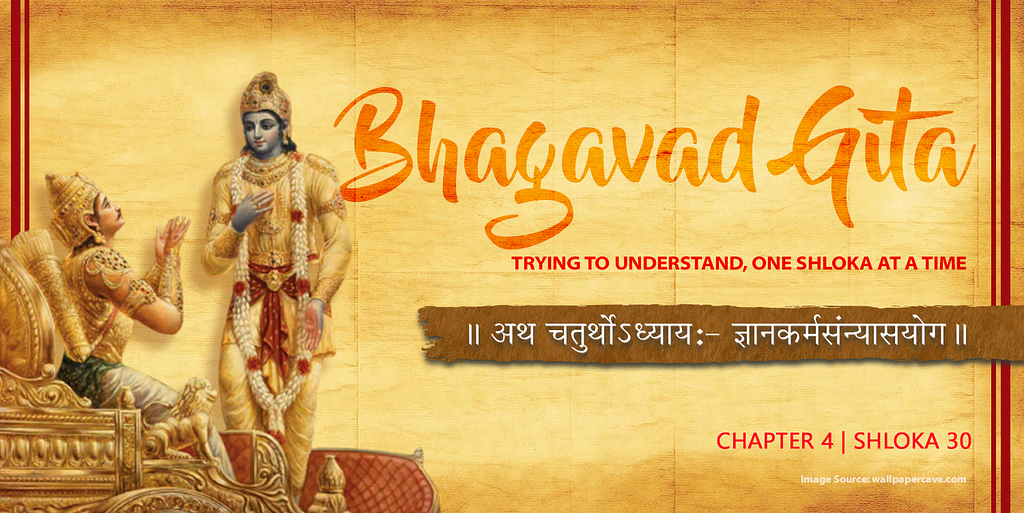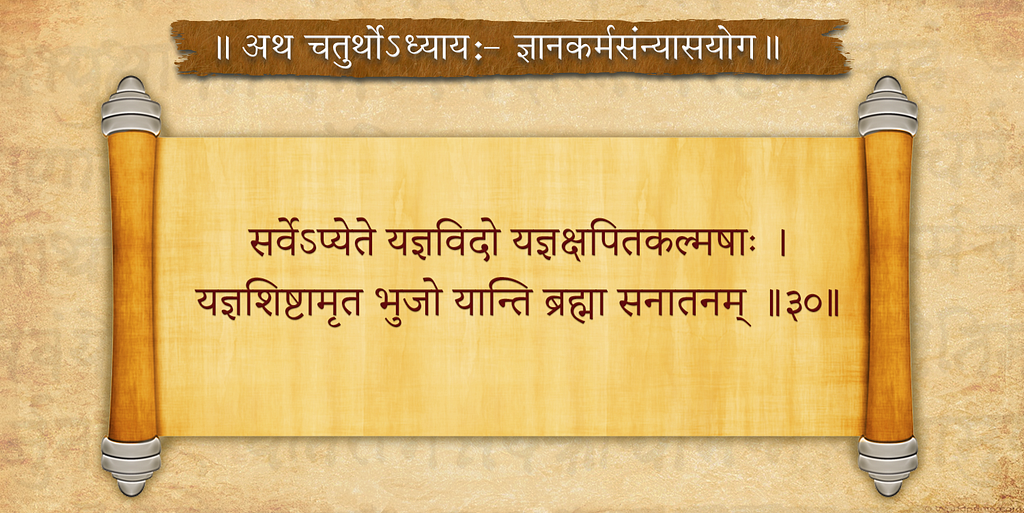H
HBR Patel
Guest
Bhagavad Gita: Understanding One Shloka at a Time. (Chp. 4, Verse 30) — HBR Patel
Trying to understand Bhagavad Gita, one Shloka at a time…

Bhagavad Gita | Poster by HBRGraphic
सर्वेऽप्येते यज्ञविदो यज्ञक्षपितकल्मषाः ।
यज्ञशिष्टामृत भुजो यान्ति ब्रह्मा सनातनम् ॥३०॥
All these performers who knew the principle of performing sacrifice, are purified of sinful reactions by the performance of sacrifice. Those who have tasted nectar as the result of performing sacrifice, reach the eternal, Ultimate Truth.

Bhagavad Gita | Poster by HBRGraphic
In this shlok, Bhagwan Shri Krishna confirms the outcome of the 12 Yagna or offering of worship to the Bhagwan. There are twelve types of sacrifices or yagnas that individuals can engage in for spiritual growth and self-realization as mentioned in the previous shloks of chapter 4.
Dev Yagna: Involves offering materials to deities and chanting mantras (4.25).
Brahma Yagna: Self-offering into the fire of the supreme Truth, achieved through meditation (4.25).
Indriya Yagna: Offering sense objects to control sense intake as an act of worship (4.26).
Ksaiyama Yagna: Offering sense organs and other organs of action(Karma-Indriya) into the fire of self-control through meditation (4.27).
Dravya Yagna: Offering material to the needy, seeing them as a form of the Lord (4.28).
Tapo Yagna: Austerities, like fasting, conserving energy, and increasing endurance (4.28).
Yoga Yagna: Involves the eight-fold steps, including postures and meditation (4.28).
Svadhyay Yagna: Spiritual practice of reading scriptures, mantra repetition, study, or introspection (4.28).
Gyan Yagna: Understanding scriptures through study, listening, or group discussion (4.28).
Vrat Yagna: Involves taking special vows to sharpen the mind and senses (4.28).
Pranayam Yagna: Guided practice controlling inhalation, exhalation, and breath-holding (4.28).
Ahar Yagna: Offering the right food in the right quantity for the digestive fire (4.30). Controlled eating becomes a spiritual practice when done as an offering, preventing obesity and diseases.
People do these different practices to become pure. Wanting pleasure for the senses and mind can make the heart impure. These practices aim to control the desire for pleasure from material things. When done as an offering to a higher power, they make the heart pure.
When yogis engage in these diverse acts of offering (yagnas) without any selfish desires, remarkable things unfold:
- Their past missteps are washed away, akin to cleansing dirt with spiritual soap.
- They relish pure joy, analogous to savoring delightful remnants after offering the finest portions to the divine.
For these yogis, the essence lies in the act of offering itself — it’s a connection with the ultimate reality, the Brahman. The “food” they partake in isn’t physical; it’s a profound inner contentment derived from living in this manner. This spiritual nourishment, like nectar, energizes their soul.
Practicing these yagnas with a pure heart purifies the practitioner, establishes a connection with the divine, and instills eternal bliss within them.
Continue reading...
